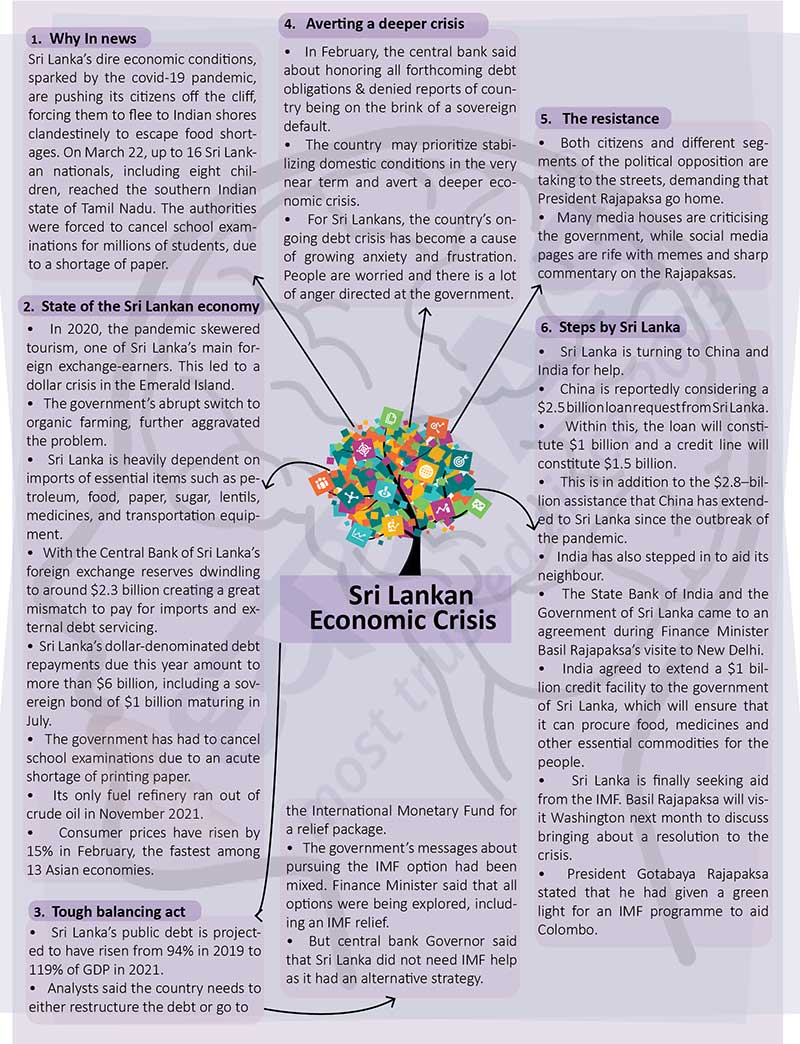Brain-booster /
15 Apr 2022
Brain Booster for UPSC & State PCS Examination (Topic: Sri Lankan Economic Crisis)

Why in news?
- Sri Lanka’s dire economic conditions, sparked by the covid-19 pandemic,
are pushing its citizens off the cliff, forcing them to flee to Indian
shores clandestinely to escape food shortages. On March 22, up to 16 Sri
Lankan nationals, including eight children, reached the southern Indian
state of Tamil Nadu. The authorities were forced to cancel school
examinations for millions of students, due to a shortage of paper.
State of the Sri Lankan economy
- In 2020, the pandemic skewered tourism, one of Sri Lanka’s main foreign
exchange-earners. This led to a dollar crisis in the Emerald Island.
- The government’s abrupt switch to organic farming, further aggravated
the problem.
- Sri Lanka is heavily dependent on imports of essential items such as
petroleum, food, paper, sugar, lentils, medicines, and transportation
equipment.
- With the Central Bank of Sri Lanka’s foreign exchange reserves dwindling
to around $2.3 billion creating a great mismatch to pay for imports and
external debt servicing.
- Sri Lanka’s dollar-denominated debt repayments due this year amount to
more than $6 billion, including a sovereign bond of $1 billion maturing in
July.
- The government has had to cancel school examinations due to an acute
shortage of printing paper.
- Its only fuel refinery ran out of crude oil in November 2021.
- Consumer prices have risen by 15% in February, the fastest among 13
Asian economies.
Tough balancing act
- Sri Lanka’s public debt is projected to have risen from 94% in 2019 to
119% of GDP in 2021.
- Analysts said the country needs to either restructure the debt or go to
the International Monetary Fund for a relief package.
- The government’s messages about pursuing the IMF option had been mixed.
Finance Minister said that all options were being explored, including an IMF
relief.
- But central bank Governor said that Sri Lanka did not need IMF help as
it had an alternative strategy.
Averting a deeper crisis
- In February, the central bank said about honoring all forthcoming debt
obligations & denied reports of country being on the brink of a sovereign
default.
- The country may prioritize stabilizing domestic conditions in the very
near term and avert a deeper economic crisis.
- For Sri Lankans, the country’s ongoing debt crisis has become a cause of
growing anxiety and frustration. People are worried and there is a lot of
anger directed at the government.
The resistance
- Both citizens and different segments of the political opposition are
taking to the streets, demanding that President Rajapaksa go home.
- Many media houses are criticising the government, while social media
pages are rife with memes and sharp commentary on the Rajapaksas.
Steps by Sri Lanka
- Sri Lanka is turning to China and India for help.
- China is reportedly considering a $2.5 billion loan request from Sri
Lanka.
- Within this, the loan will constitute $1 billion and a credit line will
constitute $1.5 billion.
- This is in addition to the $2.8–billion assistance that China has
extended to Sri Lanka since the outbreak of the pandemic.
- India has also stepped in to aid its neighbour.
- The State Bank of India and the Government of Sri Lanka came to an
agreement during Finance Minister Basil Rajapaksa’s visite to New Delhi.
- India agreed to extend a $1 billion credit facility to the government of
Sri Lanka, which will ensure that it can procure food, medicines and other
essential commodities for the people.
- Sri Lanka is finally seeking aid from the IMF. Basil Rajapaksa will
visit Washington next month to discuss bringing about a resolution to the
crisis.
- President Gotabaya Rajapaksa stated that he had given a green light for
an IMF programme to aid Colombo.









